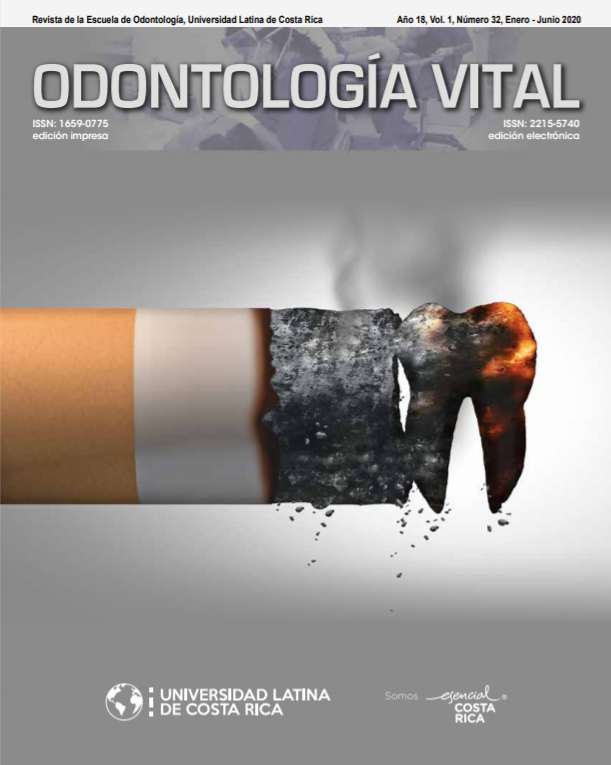Fracture resistance of crowns prepared with lithium disilicate applied to different marginal terminations F
DOI:
https://doi.org/10.59334/ROV.v1i32.379Keywords:
Dental crown, dental materials, dental restoration failure, dental preparation, lithium disilicate, chamfer, knife edge, flexural resistance, CAD–CAM, computed aided designAbstract
Objective: To evaluate the influence of the type of shoulder margins; Knife edge (F) and Chamfer (C) on the
flexural strength of CAD / CAM lithium disilicate crowns in thicknesses of 0.8 mm and 0.5 mm. Materials
and Methods: 40 healthy upper premolars, in 2 groups according to the type of termination G1 = F and G2 =
C; 2 subgroups referring to the material thickness Sg1 = 0.8mm and Sg2 0.5mm (5 crowns for each subgroup),
were subjected to vertical (v) and horizontal (h) compression forces. The most frequent type of fracture was
observed; cohesive in porcelain (cp), adhesive in porcelain (ap), mixed small (mp) and mixed long (ml). Results:
in preparations with 0.8 mm and 0.5 mm thicknesses, there was a significant difference in relation to the best
termination, this was C; their values were Sg1 (h = 1347.2 N / v = 1402.0.F; Sg1 (h = 965.6 N / v = 794.8 N) .F at 0.5
mm showed better performance against horizontal forces C; Sg2 (h = 924.8 N / v = 813.4 N) and for F; Sg2 (h =
1217.0 N / v = 576.0 N) Conclusions: the most frequent type of fracture is cp and ap finishing chamfer and knife
edge can be used safely show acceptable values of flexural strength, by reducing the thickness of the chamfer
restoration reduces its strength, the knife edge increases it.
Downloads
Published
How to Cite
Issue
Section
License
Copyright (c) 2020 Odontología Vital

This work is licensed under a Creative Commons Attribution 4.0 International License.
Authors who publish with Odontología Vital agree to the following terms:
- Authors retain the copyright and grant Universidad Latina de Costa Rica the right of first publication, with the work simultaneously licensed under a Creative Commons Attribution 4.0 International license (CC BY 4.0) that allows others to share the work with an acknowledgement of the work's authorship and initial publication in this journal.
- Authors are able to enter into separate, additional contractual arrangements for the non-exclusive distribution of the Odontología Vital's published version of the work (e.g., post it to an institutional repository or publish it in a book), with an acknowledgement of its initial publication.
- Authors are permitted and encouraged to post their work online (e.g., in institutional repositories or on their website) prior to and during the submission process, as it can lead to productive exchanges, as well as earlier and greater citation of published work.
Métricas alternativas











